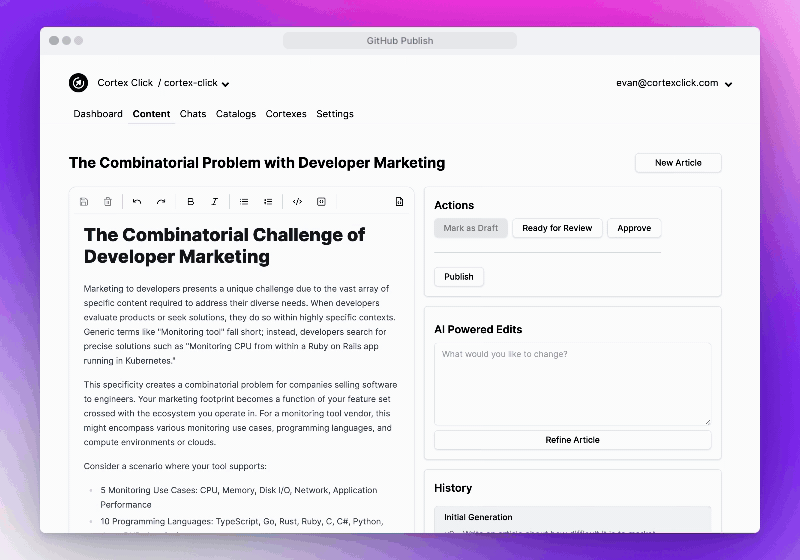
Creating content
Cortex Click provides an LLM-driven long-form content editor to speed up the process of creating high-quality, trustworthy content including:
- Blog posts
- Tutorials
- SEO-optimized landing pages
- Case studies
- Developer doumentation
Different cortexes can be created for different content types and use cases. For instance, blog writing might need access to your developer documentation catalog while writing case studies might need access to catalogs of internal data like customer meeting notes and transcripts.
We believe that quality really matters in documentation, blogs, and marketing. To generate the highest quality content possible, we employ a three-pronged strategy:
- Grounding in your Knowledge Base: Cortex Click searches across your existing developer docs, blog posts, code examples, and other marketing materials to ground content generation, add cross-links, and match brand voice.
- Real-Time Web Research: To fill in any gaps, the workflow performs web research against popular search engines. This augments your knowledge base with access to additional code examples, industry trends, and other facts and statistics.
- Multi-Agent, Adversarial Workflow: All of this context is fed into multiple frontier models from different providers that are used in concert. We leverage the strengths of different models to plan, research, draft, review, and correct the content ultimately leading to a better result than could be achieved with any one model.
Writing workflow
The content generation workflow allows you to quickly generate content grounded in your data. You'll start by generating an initial article and then using a combination of manual edits and AI refinements to get to high quality content 90% faster.
Generating the First Draft
Just provide a title and brief prompt, and Cortex Click generates a first draft. During generation, we index your knowledge base, and perform real-time web research to supplement any topics that might be missing.

The output is plain Markdown which is rendered in a WSYWIG editor that supports inline editing and full Markdown syntax.
All of the above helps the first draft of whatever you're producing be more accurate and compelling. But writing is an iterative process, and a good copilot needs to help with that too. Cortex Click is built for draft number 2,3,4 and on:
- Editable in markdown
- Highlight and refine
- Version controlled
Iterating on Content
The draft is a great starting point and solves the blank page problem. Our research shows that drafts typically need a combination of five to ten AI refinements and human edits before they're ready to publish.
Highlight any piece of text in the article and hit ⌘ K to refine it with AI. You can choose from builtin options like spell check, expand, and shorten, as well as open-ended natural language prompting.

The author is put in complete control, and has the option to accept, reject, or regenerate the suggestion until pleased with the output.
You can prompt to generate an entirely new section by hitting ⌘ K on any newline.

You can even pass URLs into prompts, and ask Cortex Click to make changes based on the contents. The engine fetches the page and extracts out the necessary data to feed to the rest of the generative workflow.

This is great for pulling in external references like code examples and style guides, and can even be used to match the formatting or tone of the content within the reference URL.
If you're working on something that doesn't yet exist in your knowledge base, like a new product launch, you can upload context documents to inform generation.

Upload PRFAQs, code examples, OpenAPI specs, and more to bootstrap your content.
Publishing a Pull Request
Many modern teams build their content – think marketing sites, docs, and blog – with some sort of Markdown builder like Hugo, Docusaurus, or GitBook. The Cortex Click GitHub app enables publishing content created within the Cortex app as a GitHub pull request with one click.

With the GitHub app, Cortex Click natively integrates with your existing content workflows like Vercel preview builds, linting, and deployments on merge via GitHub actions.
AI-Assisted Content Review
Imagine an engineer submits a PR to add docs for a feature they just built, and adds you as a reviewer. When you review a pull request you typically have two options when you encounter something you’d like to see changed:
- Add a comment and leave it to the PR author to do the work to incorporate the feedback.
- Take extra time to craft a suggested commit with the changes you’d like to propose.
With the Cortex Click GitHub app, all you have to do is tag @cortexclick in your review comment and you get a suggested commit instantly, reducing the amount of work required by both the PR reviewer and author to incorporate feedback into a piece of content. All of which translates to better documentation in less time.

Versions and diffs
In addition to AI refinements, you can view and export he markdown source of the document. Cortex Click saves every edit and refinement as an independent version, allowing you to view diffs between revisions and revert back to previous content versions.

Programmatic Publication
The intelligent content engine produces markdown output which is compatible with most CMS and docs publication systems, even if you don't use the Cortex Click GitHub app.
When new content is first created, it's marked as a Draft. Once it is ready for review from your teammates you can move it to In Review, Approved, and then finally Published. You can filter content by status from the list page, and write programs with the SDK to fetch and filter content by status for custom publication workflows.
The intelligent content engine produces markdown output which is compatible with most CMS and docs publication systems.